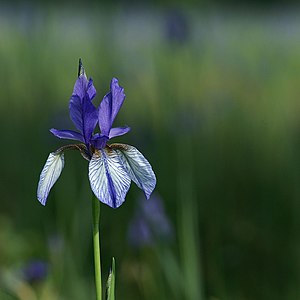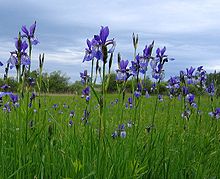Siberian iris
| Siberian iris | ||||||||||||
|---|---|---|---|---|---|---|---|---|---|---|---|---|

Siberian iris ( Iris sibirica ) |
||||||||||||
| Systematics | ||||||||||||
|
||||||||||||
| Scientific name | ||||||||||||
| Iris sibirica | ||||||||||||
| L. |
The Siberian iris ( Iris sibirica ), even Meadow Iris and Blue Iris called, is a plant from the family of the Iridaceae (Iridaceae). It is used as an ornamental plant.
description
The Siberian iris is a perennial , herbaceous plant that reaches heights of 50 to 120 centimeters. It forms compact rhizomes covered by the remains of old leaves with a diameter of 0.9 to 1.2 cm as persistence organs, which branch out and often develop large clumps . The upright, simple or up to three-fold branched stems are round and hollow. The two-line, riding leaves , dark green on both sides and slightly pink at their base, are shorter than the stem, 25 to 80 cm long and 0.4 to 0.9 cm wide.
The inflorescences contain two to five flowers. At flowering time, the narrow bracts up to 4 cm wide are brown and paper-like. The flower stalks are of different lengths, the earliest only 1 cm to and the late blooming up to 15 cm long. The threefold, hermaphrodite flowers do not smell and have a diameter of 6 to 7 cm. The "hanging leaves" are colored blue to blue-violet and 3 to 6 cm long. Your plate has a white, heavily veined spot. It suddenly narrows in the nail . This is lighter and darkly veined. The "standards" are darker and veined in purple. There is only one circle with three stamens . The pollination is done by larger insects.
The flowering period extends from May to June.
The triangular, smooth capsule fruits are 3 to 4.5 × 1 to 1.3 cm in size and only open in the upper quarter to third. The seeds are in two rows in each of the three fruit compartments. The dark brown seeds are D-shaped, flattened, 5 × 3 mm in size.
The number of chromosomes is 2n = 28.
Occurrence

The Siberian iris occurs in warm temperate to temperate Europe and western Siberia to the Altai . It grows in swampy meadow and forest meadows, in Central Europe especially in associations of the Molinion or Cnidion associations. Iris sibirica is naturalized in the east of the USA and in south-east Canada .
Systematics
The botanical species name Iris sibirica was first published in 1753 by Carl von Linné in Species Plantarum , 1, 39.
Iris sibirica L. belongs to the section: Limniris in the subgenus Limniris within the genus Iris .
use
The Siberian iris is widely used as an ornamental plant for banks of water, borders and natural gardens. It has been in culture since 1594 at the latest. There are numerous varieties (selection):
- 'Albiflora': The flowers are white and occasionally have blue veins.
- 'Möve': The flowers are ivory in color.
- 'Superba': The variety is early flowering.
Tetraploid forms with horizontal hanging leaves and larger flowers have been around since 1960.
Others
On October 22nd, 2009, the Siberian Iris was voted Flower of the Year 2010.
swell
- Norlan C. Henderson: Iris in the Flora of North America , Volume 26, 2002, p. 382: Iris sibirica - Online. (Section description)
Individual evidence
- ↑ a b Norlan C. Henderson: Iris in the Flora of North America , Volume 26, 2002, p 382: Iris sibirica - Online.
- ↑ a b c d Eckehardt J. Jäger, Friedrich Ebel, Peter Hanelt, Gerd K. Müller (eds.): Rothmaler Exkursionsflora von Deutschland Volume 5 Herbaceous ornamental and useful plants. Spectrum Academic Publishing House, Berlin Heidelberg 2008, ISBN 978-3-8274-0918-8 .
- ↑ T. Jahn, H. Pannach & MH Hoffmann: data sheet of the University of Halle, 2009.
- ↑ a b Erich Oberdorfer : Plant-sociological excursion flora for Germany and neighboring areas . With the collaboration of Angelika Schwabe and Theo Müller. 8th, heavily revised and expanded edition. Eugen Ulmer, Stuttgart (Hohenheim) 2001, ISBN 3-8001-3131-5 , pp. 142 .
- ↑ Iris sibirica in the Germplasm Resources Information Network (GRIN), USDA , ARS , National Genetic Resources Program. National Germplasm Resources Laboratory, Beltsville, Maryland.
- ↑ Archived copy ( memento of the original dated November 15, 2009 in the Internet Archive ) Info: The archive link was inserted automatically and has not yet been checked. Please check the original and archive link according to the instructions and then remove this notice.
Web links
- Siberian iris. In: FloraWeb.de.
- Siberian iris . In: BiolFlor, the database of biological-ecological characteristics of the flora of Germany.
- Profile and distribution map for Bavaria . In: Botanical Information Hub of Bavaria .
- Iris sibirica L., map for distribution in Switzerland In: Info Flora , the national data and information center for Swiss flora .
- Distribution in the northern hemisphere from: Eric Hultén , Magnus Fries: Atlas of North European vascular plants 1986, ISBN 3-87429-263-0 at Den virtuella floran (swed.)
- Thomas Meyer: Data sheet with identification key and photos at Flora-de: Flora von Deutschland (old name of the website: Flowers in Swabia )
- T. Jahn, H. Pannach & MH Hoffmann: data sheet with distribution map, 2009.
- Datasheet of botany in the picture .
- The poisonous plant Siberian iris.


